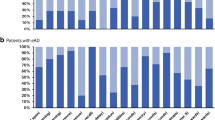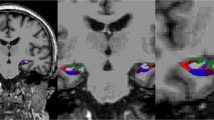Abstract
Although a large number of studies have examined possible differences in cognitive performance between Alzheimer’s disease (AD) and vascular dementia (VaD), the data in the literature are conflicting. The aims of this study were to analyze the neuropsychological pattern of subjects affected by degenerative dementia without evidence of small vessel pathology (DD) and small vessel VaD subjects in the early stages and to investigate differences in the progression of cognitive impairment. Seventy-five patients with probable VaD and 75 patients with probable DD were included. All the subjects underwent a standard neuropsychological evaluation, including the following test: Visual Search, Attentional matrices, Story Recall, Raven’s Coloured Progressive Matrices, Phonological and Semantic Verbal Fluency, Token, and Copying Drawings. The severity of cognitive impairment was stratified according to the MMSE score. Fifteen subjects with probable DD and 10 subjects with probable VaD underwent a 12-month cognitive re-evaluation. No significant difference was found between DD and VaD subjects in any of the neuropsychological tests except Story Recall in the mild cognitive impairment (P < 0.001). The re-test value was significantly worse than the baseline value in the MMSE (P = 0.037), Corsi (P = 0.041), Story Recall (P = 0.032), Phonological Verbal Fluency (P = 0.02), and Copying Drawings (P = 0.043) in DD patients and in the Visual Search test (P = 0.036) in VaD subjects. These results suggest that a neuropsychological evaluation might help to differentiate degenerative dementia without evidence of small vessel pathology from small vessel VaD in the early stages of these diseases.

Similar content being viewed by others
References
Wiesmamann M, Kiliaan AJ, Claassen JA (2013) Vascular aspects of cognitive impairment and dementia. J Cereb Blood Flow Metab 33(11):1696–1706
Iadecola C (2010) The overlap between neurodegenerative and vascular factors in the pathogenesis of dementia. Acta Neuropathol 120(3):287–296
Esiri MM, Joachim C, Sloan C, Christie S, Agacinski G, Bridges LR, Wilcock GK, Smith AD (2014) Cerebral subcortical small vessel disease in subjects with pathologically confirmed Alzheimer disease: a clinicopathologic study in the Oxford Project to Investigate Memory and Ageing (OPTIMA). Alzheimer Dis Assoc Disord 28(1):30–35
Attems J, Jellinger KA (2014) The overlap between vascular disease and Alzheimer’s disease—lessons from pathology. BMC Med 12:206
Kalaria R (2002) Similarities between Alzheimer’s Disease and vascular dementia. J Neurol Sci 203–204:29–34
Hampstead BM, Libon DJ, Moelter ST, Swirsky-Sacchetti T, Scheffer L, Platek SM, Chute D (2010) Temporal order memory differences in Alzheimer’s disease and vascular dementia. J Clin Exp Neuropsychol 32(6):645–654
Kandiah N, Narasimhalu K, Lee J, Chen CL (2009) Differences exist in the cognitive profile of mild Alzheimer’s disease and subcortical ischemic vascular dementia. Dement Geriatr Cogn Disord 27(5):399–403
McGuinness B, Barrett SL, Craig D, Lawson J, Passmore AP (2010) Executive functioning in Alzheimer’s disease and vascular dementia. Int J Geriatr Psychiatry 25(6):562–568
Voss SE, Bullock RA (2004) Executive function: the core feature of dementia? Dement Geriatr Cogn Disord 18(2):207–216
Cavalieri M, Enzinger C, Petrovic K, Pluta-Fuerst A, Homayoon N, Schmidt H, Fazekas F, Schmidt R (2010) Vascular dementia and Alzheimer’s disease—are we in a dead-end road? Neurodegener Dis 7:122–126
Stokholm J, Vogel A, Gade A, Waldemar G (2006) Heterogeneity in executive impairment in patients with very mild Alzheimer’s disease. Dement Geriatr Cogn Disord 22(1):54–59
Clark RL, Schiehser DM, Weissberger GH, Salmon DP, Delis DC, Bondi MW (2012) Specific measures of executive function predict cognitive decline in older adults. J Int Neuropsychol Soc 18(1):118–127
Reed BR, Mungas DM, Kramer JH, Ellis W, Vinters HV, Zarow C, Jagust WJ, Chui HC (2007) Profiles of neuropsychological impairment in autopsy-defined Alzheimer’s disease and cerebrovascular disease. Brain 130(Pt 3):731–739
Roman GC, Tatemichi TK, Erkinjuntti T, Cummings JL, Masdeu JC, Garcia JH, Amaducci L, Orgogozo JM, Brun A, Hofman A (1993) Vascular dementia: diagnostic criteria for research studies. Report of the NINDS-AIREN international workshop. Neurology 43(2):250–260
American Psychiatric Association (2000) Diagnostic and statistical manual of mental health disorders, 4th edn. American Psychiatric Association, Washington (Text revision)
Folstein MF, Folstein SE, McHugh PR (1975) “Mini-mental state”. A practical method for grading the cognitive state of patients for the clinician. J Psychiatr Res 12(3):189–198
Spinnler H, Tognoni G (1987) Standardizzazione e taratura italiana di test neurpsicologici. Ital J Neurol Sci Suppl. 8:1–120
Novelli G, Papagno C, Capitani E, Laiacona M, Cappa SF, Vallar G (1986) Tre test clinici di memoria verbale a lungo termine: taratura su soggetti normali. Archo Psicol Neurol Psichiat 47:278–296
Raven JC (1941) Standardization of progressive matrices. Br J Med Psychol 19(1):137–150
Basso A, Capitani E, Laiacona M (1987) Raven’s coloured progressive matrices: normative values on 305 adult normal controls. Funct Neurol 2(2):189–194
Borkowski JG, Benton AL, Spreen O (1967) Word fluency and brain damage. Neuropsychologia 5(2):135–140
De Renzi E, Vignolo LA (1962) The token test: a sensitive test to detect receptive disturbances in aphasics. Brain 85:665–678
Benton AL (1969) Development of a multilingual aphasia battery. Progress and problems. J Neurol Sci 9(1):39–48
Bergmann HC, Rijpkema M, Fernández G, Kessels RP (2012) Distinct neural correlates of associative working memory and long-term memory encoding in the medial temporal lobe. Neuroimage 63(2):989–997
Jeneson A, Squire LR (2011) Working memory, long-term memory, and medial temporal lobe function. Learn Mem 19(1):15–25
Pasquier F (1999) Early diagnosis of dementia: neuropsychology. J Neurol 246(1):6–15
Lezak MD, Howieson DB, Loring DW (2004) Neuropsychological assessment, 4th edn. Oxford University Press, New York, pp 444–448
Traykov L, Baudic S, Raoux N, Latour F, Rieu D, Smagghe A, Rigaud AS (2005) Patterns of memory impairment and perseverative behavior discriminate early Alzheimer’s disease from subcortical vascular dementia. J Neurol Sci 229–230:75–79
Sarazin M, Berr C, De Rotrou J, Fabrigoule C, Pasquier F, Legrain S, Michel B, Puel M, Volteau M, Touchon J, Verny M, Dubois B (2007) Amnestic syndrome of the medial temporal type identifies prodromal AD. Neurology 69(19):1859–1867
Moorhouse P, Rockwood K (2008) Vascular cognitive impairment: current concepts and clinical developments. Lancet Neurol 7(3):246–255
Posner MI, Fan J (2008) Attention as an organ system “Attention as an organ system”. In: Pomerantz JR (ed) Topics in integrative neuroscience: from cells to cognition. Cambridge University Press, New York, pp 31–61
Eimer M (2014) The neural basis of attentional control in visual search. Trends Cogn Sci 18(10):526–535
Raz A (2004) Anatomy of attentional networks. Anat Rec B New Anat 281(1):21–36
Karnath HO (2001) New insights into the functions of the superior temporal cortex. Nat Rev Neurosci 2(8):568–576
Jacobs HI, Visser PJ, Van Boxtel MPJ (2012) The association between white matter hyperintensities and executive decline in mild cognitive impairment in network dependent. Neurobiol Aging 33(1):201
Parks CM, Iosif AM, Farias S, Reed B, Mungas D, DeCarli C (2011) Executive function mediates effects of white matter hyperintensities on episodic memory. Neuropsychologia 49(10):2817–2824
Blom K, Emmelot-Vonk MH, Koek HL (2013) The influence of vascular risk factors on cognitive decline in patients with dementia: a systematic review. Maturitas 76(2):113–117
O’Brien JT, Markus HS (2014) Vascular risk factors and Alzheimer’s disease. BMC Med 12:218
Gorelick PB, Scuteri A, Black SE, Decarli C, Greenberg SM, Iadecola C, Launer LJ, Laurent S, Lopez OL, Nyenhuis D, Petersen RC, Seshadri S (2011) Vascular contributions to cognitive impairment and dementia: a statement for healthcare professionals from the american heart association/american stroke association. Stroke 42(9):2672–2713
Pavlovic AM, Pekmezovic T, Tomic G, Trajkovic JZ, Sternic N (2014) Baseline predictors of cognitive decline in patients with cerebral small vessel disease. J Alzheimers Dis 42(Suppl 3):S37–S43
Author information
Authors and Affiliations
Corresponding author
Ethics declarations
Conflict of interest
The authors declare that there is no conflict of interests regarding the publication of this manuscript.
Rights and permissions
About this article
Cite this article
De Carolis, A., Cipollini, V., Donato, N. et al. Cognitive profiles in degenerative dementia without evidence of small vessel pathology and small vessel vascular dementia. Neurol Sci 38, 101–107 (2017). https://doi.org/10.1007/s10072-016-2716-5
Received:
Accepted:
Published:
Issue Date:
DOI: https://doi.org/10.1007/s10072-016-2716-5




